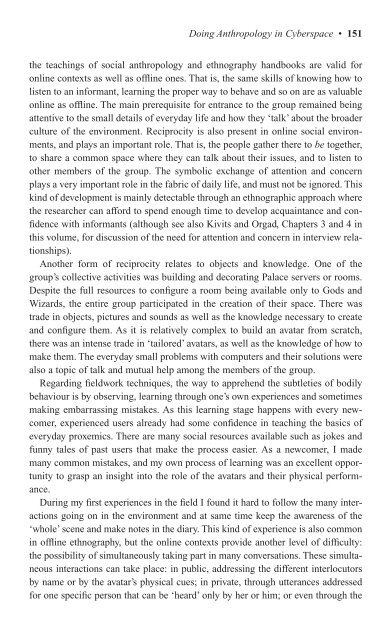Virtual Methods
Virtual Methods
Virtual Methods
You also want an ePaper? Increase the reach of your titles
YUMPU automatically turns print PDFs into web optimized ePapers that Google loves.
Doing Anthropology in Cyberspace • 151<br />
the teachings of social anthropology and ethnography handbooks are valid for<br />
online contexts as well as offline ones. That is, the same skills of knowing how to<br />
listen to an informant, learning the proper way to behave and so on are as valuable<br />
online as offline. The main prerequisite for entrance to the group remained being<br />
attentive to the small details of everyday life and how they ‘talk’ about the broader<br />
culture of the environment. Reciprocity is also present in online social environments,<br />
and plays an important role. That is, the people gather there to be together,<br />
to share a common space where they can talk about their issues, and to listen to<br />
other members of the group. The symbolic exchange of attention and concern<br />
plays a very important role in the fabric of daily life, and must not be ignored. This<br />
kind of development is mainly detectable through an ethnographic approach where<br />
the researcher can afford to spend enough time to develop acquaintance and confidence<br />
with informants (although see also Kivits and Orgad, Chapters 3 and 4 in<br />
this volume, for discussion of the need for attention and concern in interview relationships).<br />
Another form of reciprocity relates to objects and knowledge. One of the<br />
group’s collective activities was building and decorating Palace servers or rooms.<br />
Despite the full resources to configure a room being available only to Gods and<br />
Wizards, the entire group participated in the creation of their space. There was<br />
trade in objects, pictures and sounds as well as the knowledge necessary to create<br />
and configure them. As it is relatively complex to build an avatar from scratch,<br />
there was an intense trade in ‘tailored’ avatars, as well as the knowledge of how to<br />
make them. The everyday small problems with computers and their solutions were<br />
also a topic of talk and mutual help among the members of the group.<br />
Regarding fieldwork techniques, the way to apprehend the subtleties of bodily<br />
behaviour is by observing, learning through one’s own experiences and sometimes<br />
making embarrassing mistakes. As this learning stage happens with every newcomer,<br />
experienced users already had some confidence in teaching the basics of<br />
everyday proxemics. There are many social resources available such as jokes and<br />
funny tales of past users that make the process easier. As a newcomer, I made<br />
many common mistakes, and my own process of learning was an excellent opportunity<br />
to grasp an insight into the role of the avatars and their physical performance.<br />
During my first experiences in the field I found it hard to follow the many interactions<br />
going on in the environment and at same time keep the awareness of the<br />
‘whole’ scene and make notes in the diary. This kind of experience is also common<br />
in offline ethnography, but the online contexts provide another level of difficulty:<br />
the possibility of simultaneously taking part in many conversations. These simultaneous<br />
interactions can take place: in public, addressing the different interlocutors<br />
by name or by the avatar’s physical cues; in private, through utterances addressed<br />
for one specific person that can be ‘heard’ only by her or him; or even through the



